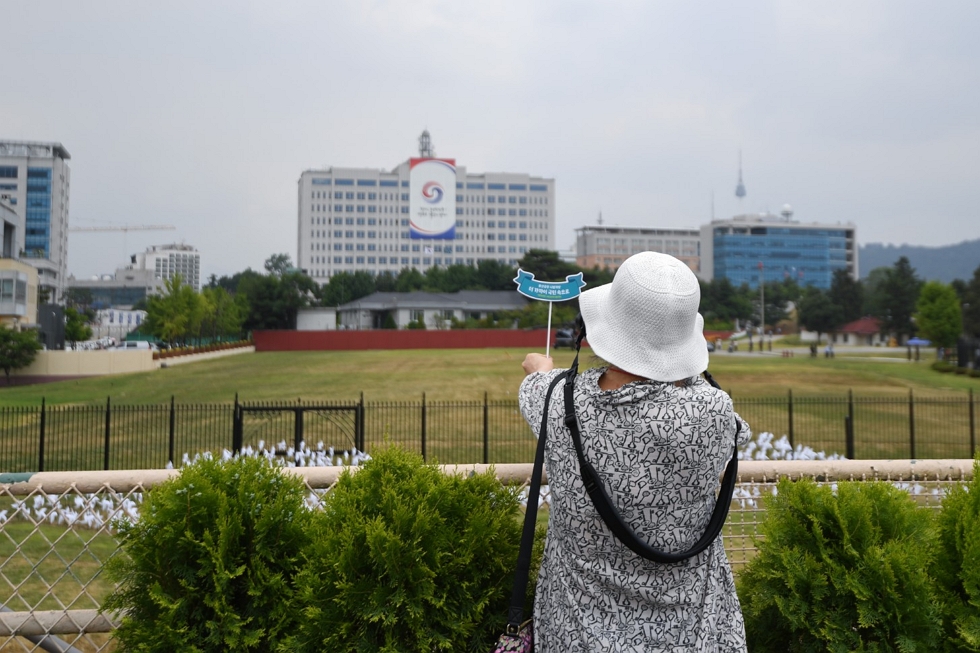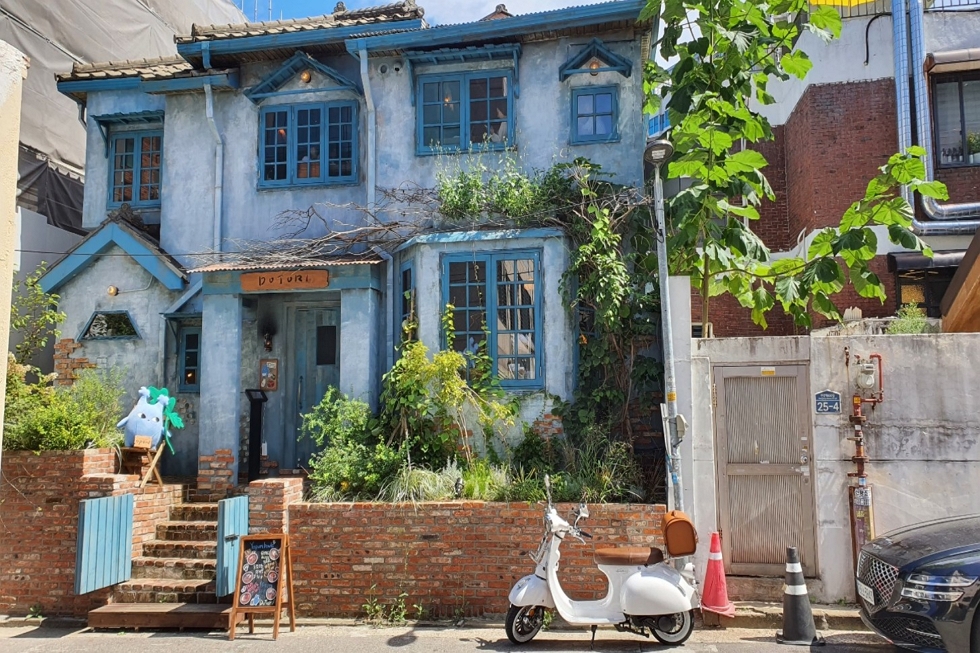[Sept] Yongsan emerging as hotspot – politically, culturally
Date Sep 21, 2022
 A woman takes a picture of the new Office of the President from a section of Yongsan Park temporarily opened in June. That section and all of the former U.S. military base that has occupied the land since 1945 will be turned into a huge park in central Seoul.
A woman takes a picture of the new Office of the President from a section of Yongsan Park temporarily opened in June. That section and all of the former U.S. military base that has occupied the land since 1945 will be turned into a huge park in central Seoul.
The Yongsan-gu District is on the north bank of the Hangang, in the center of Seoul. Yet, most Koreans have never been allowed to see a large portion of Yongsan even though it sits in the middle of their capital. This is mainly because nearly a quarter of the district was taken up by a huge U.S. military base, Yongsan Garrison.
However, a new era has arrived in Yongsan: the Yongsan Garrison has been nearly completely relocated further south of Seoul, and the Office of the President moved to the district after the election of President Yoon Suk Yeol. With more and more parts of the area opening to the public, Yongsan is becoming a new hub of politics, government administration and culture.
The area has been a logistics hub since the Joseon Dynasty (1392-1910), and Chinese troops were stationed there in 1884 during the First Sino-Japanese War. In 1904, even before its 1910-45 colonial occupation of the Korean Peninsula, Japan forcibly took the land and the Japanese Imperial Army built a base there in 1906. After the Japanese left Korea following their defeat in World War II, the former Japanese Army base was taken over by the U.S. military government.
What was intended as a makeshift U.S. base no longer remained temporary after the 1950-53 Korean War broke out. The U.S. military reinforced the base during the war and afterward more U.S. troops and the United Nations Command moved to Yongsan. The Korea-U.S. Combined Forces Command was also set up there as well as Korea’s defense ministry and the Joint Chiefs of Staff – turning Yongsan into the heart of Korea’s military and the ROK-U.S. alliance.
But following an agreement between Korea and the United States, most of the Yongsan base’s functions and personnel have been transferred to Camp Humphreys in Pyeongtaek, Gyeonggi-do Province, since the mid-2010s.
Once the U.S. Forces Korea began returning land a couple decades ago – large swaths being used for the National Museum of Korea and Yongsan Family Park – the central government and the Seoul Metropolitan Government decided to turn the remainder of the base into a park, named Yongsan Park. Detailed discussions on development plans have been ongoing for years. In the meantime, a section of the park has been opened to the public since 2020, and another section was temporarily opened for a limited period in June this year.
The Yongsan Park development plan is likely to accelerate following the relocation of the presidential office from Cheong Wa Dae in Jongno-gu District to the former defense ministry building, which will be linked to the envisioned park.
Opening the former military base site to the public and returning the land to Korean citizens corresponds with the Yoon administration’s stated intent for moving the presidential office: to enhance communication with the public.
Besides the National Museum of Korea and Yongsan Family Park, the future Yongsan Park will have the War Memorial of Korea and the National Hangeul Museum along its edges. There are expectations that the area, with all of the facilities and parks combined, can become a Korean version of the National Mall in Washington, D.C., where the U.S. Capitol, Lincoln Memorial, Washington Monument and other museums are gathered as well as the White House.
 A cafe near the new Office of the President in Yongsan. A cluster of cafes and restaurants with a wide variety of international cuisines can be found here in “Yongnidan-gil.”
A cafe near the new Office of the President in Yongsan. A cluster of cafes and restaurants with a wide variety of international cuisines can be found here in “Yongnidan-gil.”
Yongsan’s appeal to young Koreans rekindled
To young people, history and politics may not be common keywords linked to Yongsan. Their first thoughts might go to dozens of restaurants and cafes in a small neighborhood between Samgakji Station and Sinyongsan Station on subway Line 4. These venues have been generating a lot of photos and likes on social media.
The area is now known as Yongnidan-gil, having earned the suffix spawned by Seoul’s once-trendy Gyeongnidan-gil, a neighborhood running from Yongsan Garrison’s old northeast gate up to the Grand Hyatt on Namsan. After being “discovered” by young Korean influencers, that enclave of often expat-owned cafes, bars and restaurants was swarmed seemingly overnight with new customers and expanded rapidly. Gyeongnidan-gil literally means Armed Central Finance Corps-Street – named for the Korean military unit once stationed there – but now attaching “-nidan-gil” to the name of a neighborhood in Korea, instantly conveys the sense of an up-and-coming hot spot. Hence, this part of Yongsan – just west of the coming Yongsan Park and east of Yongsan Station – has morphed into Yongnidan-gil.
Dozens of unique eateries are clustered in the area, many in remodeled old houses or shops. Some of them give off an exotic ambience, with interiors and props that make people wonder if they are in the middle of Seoul or Hong Kong, Laos, Vietnam or Japan.
The hip neighborhood is likely to expand at least for the next couple of years, building upon the relocation of the presidential office, the Seoul Metropolitan Government’s planned development of a former train maintenance depot there and the scheduled opening of Yongsan Park.
**If you have any questions about this article, feel free to contact us at kocis@korea.kr.**

The Ministry of Culture, Sports and Tourism's "Korea Here & Now" work can be used under the condition of "Public Nuri Type 1 (Source Indication)."




